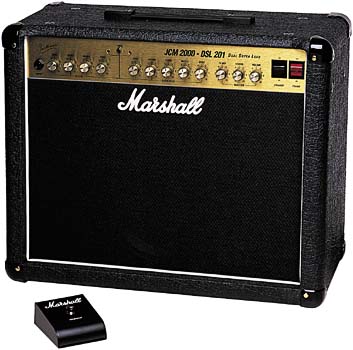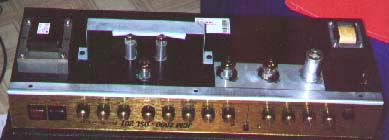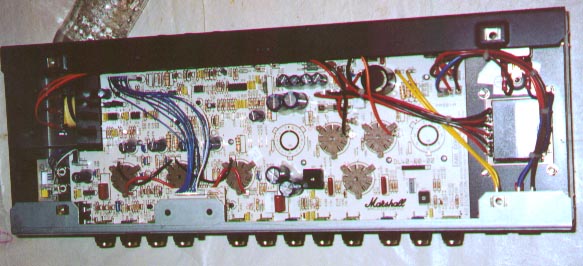Throughout its history spanning nearly 40 years, Marshall has continued to produce amplifiers that have been successfully adopted and used by musicians worldwide. As the years progressed, Marshall amplifiers came offered with a variety of additional features to suit the needs and requests of musicians through changing times. Nowadays, a fully equipped Marshall incorporates two or three channels, reverb, an effects loop, speaker-emulated direct outs, additional preamp stage gain, as well as a wide array of independent tones and volume controls for each available channel.
Power requirements have changed as well. With today’s modern p.a. systems being more than suitable to run the entire band, it is no longer required to run a Marshall stack at full  volume and save the p.a. system “just for the vocals”. Today’s guitarists playing club gigs will often mike up through house sound, hence the increased popularity of guitar amplifiers that incorporate their gain within the preamp stage instead of getting distortion by overloading the power tubes. There are benefits and drawbacks to this distortion approach and it is one that truly goes beyond the scope of this article so it will not be discussed here. However, when all is said and done, musicians in general seem to appreciate the added flexibility that additional preamp gain stages provide.
volume and save the p.a. system “just for the vocals”. Today’s guitarists playing club gigs will often mike up through house sound, hence the increased popularity of guitar amplifiers that incorporate their gain within the preamp stage instead of getting distortion by overloading the power tubes. There are benefits and drawbacks to this distortion approach and it is one that truly goes beyond the scope of this article so it will not be discussed here. However, when all is said and done, musicians in general seem to appreciate the added flexibility that additional preamp gain stages provide.
Marshall’s JCM 2000 Dual Super Lead series of amps are designed for musicians that require two independent channels of pure tube Marshall tone at a reasonable price. Models are available in a variety of wattages, from the 100 watt DSL 100 head, down to the baby of the line, the 20 watt DSL 201 combo. For those in need of three channels and wish to pay an added premium, Marshall also offers its JCM 2000 Triple Super Lead Series. For this review however, we’ve opted to take a look at Marshall’s 20 watt DSL 201 combo. As a practice amp, or as a club or gigging amp, the DSL 201 offers a wide range of tonal options.
Features
The DSL 201 is a tube combo that features twelve controls between its two channels. Channel one is voiced for clean and incorporates Gain, Treble, Middle, and Bass controls. Channel two is voiced for overdrive and includes Gain, Volume, Treble, Middle, and Bass controls. Both channels share controls for FX Mix, Reverb, and Master Volume. A standard Presence control, used by Marshall since the beginning, is oddly enough not incorporated on this particular amp.
The DSL 201 uses a pair of EL84 tubes (most famous for their use in Vox amplifiers; notably the AC30 Top Boost) in the power stage and four ECC83/12AX7 preamp tubes. The DSL 201 also has a single input and a standby and illuminated power switch.
The back panel has a standard speaker emulated D.I. out jack, FX Loop, loudspeaker output jack, AC 120V input receptacle, and two fuses. The rear panel also has a channel footswitch jack. Housed within the DSL 201’s chassis itself is a Celestion G12E-50 12 inch speaker 16 ohm speaker.
Finally, a footswitch is included with the DSL 201 to allow switching between each of the amp’s two channels. There is no additional switch available to turn reverb on or off however and this would have been a nice touch. All in all though, the Marshall DSL 201 incorporates a solid range of features that most players will find very easy to use and versatile.
Construction
The construction quality of new amplifiers in general is often a heated debate amongst musicians. On one hand there is the perspective that most or all new amplifiers being produced today are built with the lowest-grade components and utilize poor assembly technique to ensure the lowest cost as well as to ensure maximum profitability. Gone are  the days of the “hand-wired” boards from the classic amplifiers produced in the 50’s, 60’s and 70’s. To those same people, those particular periods of history were also the times when amplifiers were made the best.
the days of the “hand-wired” boards from the classic amplifiers produced in the 50’s, 60’s and 70’s. To those same people, those particular periods of history were also the times when amplifiers were made the best.
Realistically though, we need to understand that to hand wire components and chassis-mount all the volume and tone pots will result in a higher cost and that musicians themselves will ultimately have to absorb the difference. It is no secret that most musicians are sensitive to prices and so companies need to market and produce its products with those things in mind. A hand wired, point-to-point built Marshall (or any amp for that matter) could never be built today in enough quantity and at a low enough price to appeal to the majority of musicians. So with that realistic thought in mind, let’s now talk about the construction quality of the DSL 201.
From the outside, the amp appears as sturdy as any other Marshall, old or new. Covered in heavy elephant grain vinyl with protective plastic corners, and using sonically transparent black grill cloth trimmed with white vinyl piping, the DSL 201 is both rugged and handsome. Opening up the chassis, it too is fashioned out of medium gauge metal and is sturdily built.
 The electronic circuit is certainly the norm of today’s standards, with Marshall opting to incorporate all tube sockets and control knobs directly onto the DSL 201’s circuit board. While I’m personally not a big fan of tube sockets being mounted onto the PCB, I do understand that this is a realistic method to reduce costs. I’m also not in favor of the plastic components used such as all of the direct PCB-mounted potentiometers.
The electronic circuit is certainly the norm of today’s standards, with Marshall opting to incorporate all tube sockets and control knobs directly onto the DSL 201’s circuit board. While I’m personally not a big fan of tube sockets being mounted onto the PCB, I do understand that this is a realistic method to reduce costs. I’m also not in favor of the plastic components used such as all of the direct PCB-mounted potentiometers.
Only time will tell how long amplifiers that are built in this fashion will last before parts such as the plastic pots fail. One thing is clear however: the cost for repairing the DSL 201 after the warranty has expired will certainly be more so then a typical amp built with conventional chassis mounted parts. The costs I’m referring to specifically aren’t just with the parts. Working on a design like the DSL 201 is also going to cost more because repairs will also be more labor-intensive.
The bottom line is that for the majority of players out there, the construction of the DSL 201 is certainly fair. Treated with care and with a little luck, the amplifier should provide many years of trouble-free operation. Those concerned with the modern construction methods used would probably best be served by purchasing a used vintage amp of their liking (this is not without its own problems as well), or consider the boutique amplifier market (a niche and costly route).
Sound
For a reasonably priced tube combo amp, the DSL 201 has a nice range of tones. Its clean channel is rather warm and has a good overall feel which was a surprise considering that “clean” is something that Marshall’s are not particularly known for. Turning up the gain control on the clean channel and increasing the mids provided some nice bluesy tones. Backing off the gain and increasing the master and treble allowed for a nice glasslike clean sound. The tone controls’ frequencies are well selected and I enjoyed playing through channel one very much.
Channel two provides a wide range of distortion, from a harder-edged blues sound to all out metal. Nice sustain resulted from the preamp stage and the buzziness of typical preamps was relatively minimal. Turning up the master and playing loudly, the DSL 201 still had a nice attack, but it did start to sound a bit muddy in the mix. I couldn’t help but think that this little amp could do so much more if it only had a presence control like most other Marshalls. All it needs is a little extra brilliance, which is what the presence control is made for, but alas neither channel has it. Kind of a bummer because this amp is almost there tone-wise.
The reverb effect is quite nice, though it does not offer as dramatic a sound as many other reverbs in other amplifiers. Its decay is smooth thankfully and for those that like a moderate amount of reverb in the mix, I’m sure that the DSL 201’s will be more than just satisfactory.
For practice, recording, and even gigging at smaller venues, most people will find the DSL 201’s tone (or its larger 40 watt DSL 401) quite satisfying. It is indeed one of the better sounding Marshall combos that I’ve played in years. And while it’s not a tone that makes me overly excited to play to make it a “must have” amplifier, I think this has more to do with the fact that I’ve perhaps played through too many great tube amps over the years and perhaps am a little spoiled. All in all, Marshall should be applauded for producing a great little tone box in the DSL 201.
Conclusion
The DSL 201 marks a vast improvement in tonal versatility over both its JCM 900 and JCM 800 predecessors. Its clean tone especially is worthy of commendation and is also quite useful. While I’m still hesitant to speak highly of the DSL 201’s quality due to concerns with the circuit board design, this is quite normal in just about everyone’s designs today and it is simply a requirement for making sure that tube amplifiers can still be affordable. As a result, I’m not going to severely “knock” down the DSL 201’s overall rating because of that as it would be unfair.
What is most important to musicians besides affordability of course is tone. And I must say that the DSL 201 does do a nice job supplying all kinds of tones for all types of music. While it can get a little muddy when cranked up using channel two, this is probably something that could be corrected fairly easily with some e.q. running through the effects loop. Given all of the pluses and minuses, the Marshall DSL 201 does offer a good value and a nice tube sound in a portable package.